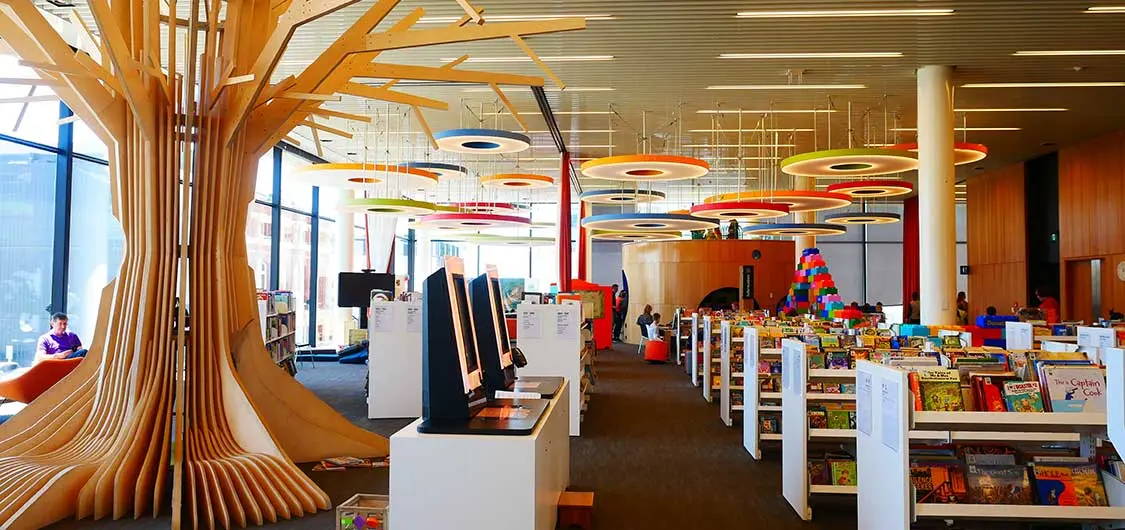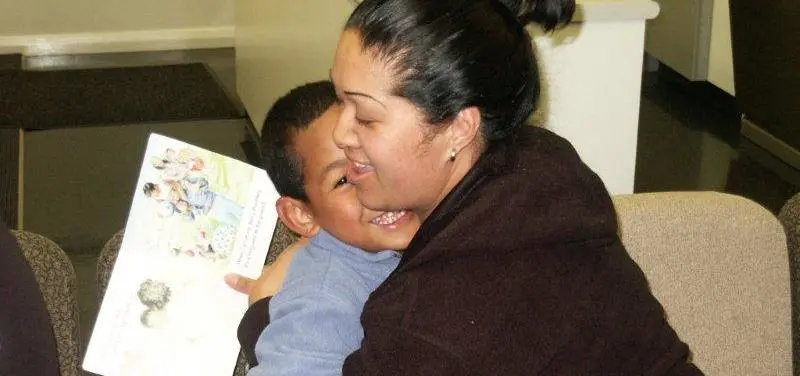Collaborating with public libraries

Image credit: Photo by Sgerbic. Wikimedia Commons. CC BY-SA 4.0. Image cropped.
Working with your local public library improves student access to reading resources, services, and programmes. It supports reading for pleasure at home and during the holidays. Collaborating also helps public libraries respond to curriculum needs.
Learn about your local public library
Check out your local library's website and social media channels to see what programmes and activities they run for students.
Directory of New Zealand libraries — contact details and locations of New Zealand libraries.
Public Libraries of New Zealand’s interactive map — find a public library near you.
Develop a partnership with your public library
Developing a rapport and good communication with your public library allows you to share opportunities, ideas, and information to support students.
Chat with colleagues to see who is in contact with your local librarian (some of the larger libraries have a youth services librarian). This will ensure communication is coordinated where possible.
Arrange a meeting to get to know each other and to learn about various programmes.
Having more than one person involved at the school and public library helps create a sustainable relationship if people move on from roles.
If you're a school librarian, invite your local public librarian to a school library network meeting. Ask if they'd like to join your local network.
Regular communication means each party is aware of the workload and stresses of the other.
Developing a partnership also allows you to schedule and run events that are of mutual interest to you both.
Set clear expectations of what you both want out of any collaboration.
Collaborations and partnerships
Invite the public library to your school
Invite your local public librarians to visit your school to:
meet staff to discuss their library's services, programmes, and resources
learn about your school community, resources, and study topics or themes
showcase books, read aloud, be guests or judges to help at assemblies, family events, school library events such as Book Week, and in classes — in person or virtually
promote holiday activities, programmes, competitions, membership, and resources
connect with student librarians
take part in external programmes and visits with a reading focus, such as the Reading Together programme, Duffy Books for Schools, Storylines, and Writers in Schools visits
contribute to after-school programmes.
Arrange for a visit from the public library's mobile library bus (if they have one).
Increase visibility of your school at the public library
Offer to share students' work for display in the public library, such as reading-responses, artwork, poetry, stories, and book reviews and recommendations.
Ask if students could help at the public library. They could create displays, or make bookmarks or shelf-talkers, saying why they enjoyed particular books. They could also provide input into their library's collection development plan.
Organise student visits to the public library
Provide opportunities for students to visit the public library during school time. Arrange a time with the public library and discuss how to make the most of your visit.
Does the library offer guided tours? Do they cater for a variety of age groups?
What reading-related activities or programmes do they have? These might include storytime sessions, author events, competitions, book launches, book groups, or holiday programmes.
Are there specific services for children and teens?
If your school library is being refurbished or used as an overflow classroom, can class library times be held at the public library instead?
It's useful to let the public library know your students' ages and interests. Consider any themes or topics they could tie into, particularly during a storytime session.
Ask what level of involvement from school staff is appropriate. Your engagement and enthusiasm during the visit will make a difference and have a positive impact on student behaviour.
Follow-up after your first class visit
Some suggested follow-up actions include:
Review the visit and discuss any feedback to help improve future visits.
Think about your objectives for the visit. Were these met?
What impact did it have on the students?
Has it helped to increase membership at the public library?
Share results of the visit with school and public library staff.
It’s not just about one-off events and visits — although those can be part of the collaboration. It’s about an ongoing relationship and reciprocal support.
School/student membership and borrowing
Membership and borrowing policies can vary between public libraries. Find out if your local library:
offers group membership to schools and what access to resources is included or excluded from school, class, or student memberships
allows a school to apply for more than one membership
encourages students to have their own library card, and if they have a service to help bulk sign-up of classes
alerts members to upcoming overdues by email, text, RSS, phone, or letter
charges students for overdue items — consider how your school might organise a fortnightly or monthly return of public library books
holds homework clubs, or has wifi and space available to complete homework with or without information literacy support from librarians.
Promote the public library to students and families
Encourage school staff to regularly promote the public library to students. Highlight the importance of its services and how they can support reading and learning.
Promoting to students
'Walk the talk'. Talk to students about borrowing from the public library. Show them your library card. Talk about when you visit the library.
Discuss similarities and differences between the public and school library.
Publicise the public library and its location, opening hours, and contact details on flyers, posters, newsletters, school websites, and social media. Ask the local library to send you regular emails about events and updated services to display in the school library.
Many public libraries have useful social media feeds and websites — with book lists and resources for loan, including eBooks, eAudiobooks, eMagazines, and more. Ensure your students know how to borrow these and about any technical requirements.
Encourage older students to use the public library regularly.
Find out how many students are members and use the public library. Use the data as part of a promotional campaign or set a school goal of increasing membership by x%.
Promoting to families and whānau
Encourage families and whānau to visit and join the public library with their children. Communicate with them regularly about the importance of students reading for pleasure and having plenty of reading material to choose from. Check your local library's opening hours.
Public Libraries of New Zealand’s interactive map — find your nearest library and click through to their website and opening hours.
Work with the public library to send membership forms and promotional material to families, especially those new to the school. Suggest that:
families check their local library website for resources and information
students ask their parents, siblings, and other whānau to join and use the public library
families take part in events such as summer reading challenges.
Home-school reading partnerships
Summer reading — includes information for families, schools, and public libraries about encouraging students to read over summer to help prevent the ‘summer slide’ in reading.
Joint-use libraries — examples of collaboration
What’s yours is mine and mine is yours: Synergy in joint-use libraries — Eskett, Jefferson & Simpson, 2019.
McKenzie College & Community Library
School Librarians of Aotearoa: Paul Munnerley — a Sapling article about Hurunui College Library and Hawarden Community Library in North Canterbury.
Find out more
Public Library and School Library Collaboration Toolkit — created by the AASL/ALSC/YALSA Interdivisional Committee on School/Public Library Cooperation.
Supporting young learners journey: Let’s work together — Miriam Tuohy's presentation at LIANZA 2019 conference (scroll the page to find the presentation under 'Breakout 03').
